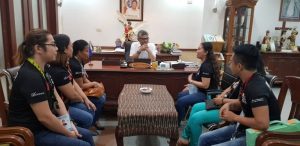| More than five hundred thousand households are estimated targets for the 3rd round household assessment of the Department of Social Welfare and Development (DSWD) through the National Household Targeting System for Poverty Reduction (NHTS-PR) in the region for 2019.
Listahanan is an information management system that employs geographic targeting, household assessment, and validation in order to provide national government agencies, development partners, and other social protection actors with information on who and where the poor are in the Philippines. This information is then used for the identification and selection of potential beneficiaries for various poverty alleviation and social protection programs. Based on Executive Order 867 series of 2010 the Department shall maintain the system and serve as the repository of the data of poor households and shall update the data every 4 years. Regional Director Mita Chuchi Gupana-Lim clarified that the given target of household to be assessed is based on the growth rate (population), however this can be exceeded during the actual enumeration. “The figure given is just an estimated target based on the growth rate of the region as well as for the budget purposes only. We already instructed our hired field workers not to stick on the target and ensure to assess more so that no one is left behind and will not be deprived of assistance from the government,” Lim said.  For Listahanan 3, the department will execute Memorandum of Understanding (MOU) with the Department of Interior and Local Government to strengthen the participation of the Local Government Units during the household assessment. The DILG will circulate the Memorandum and indicate the distinct roles and responsibilities of BLGUs and LGUs to ensure that all households will be assessed. Policies and Plans Division Chief Ramil M. Taculod said that the agency is working with the LGUs, through the DILG to ensure the success of the household validation. “The MOU between DILG and DSWD will ensure that households living in the Geographically Isolated and Disadvantaged Areas (GIDAs) will be included as the BLGUs will give guidance to our enumerators,” Taculod said. “However, any officials are prohibited to look or read the information collected by the enumerators as we are guided by the Data Privacy Act of 2012 or the R.A. 10963. Any violators will be penalized under the law. This will also serve as protection to ensure that our data is not politicized by any officials,” Taculod added. The identification of poor households follows a four-phase project cycle. First is the Preparatory Phase where target areas for household assessment and the appropriate data collection strategies are identified. The Department also capacitated all field workers on their roles and responsibilities as well as the protocol in conducting the household assessment. This is followed by the Data Collection and Analysis Phase. During this phase, where DSWD-hired enumerators conduct household interviews to gather basic and socio-economic information using the Household Assessment Form (HAF), which is then processed through a proxy means test (PMT) that estimates family income and compares it to the provincial poverty threshold. For the last phases, the results of the PMT are then validated locally, finalized, compiled, and generated into National and Regional Profiles of the Poor. As of now, the trained Area Coordinators already made a courtesy call to LGUs to discuss the importance of the conduct of the 3rd round household assessment. The first household assessment was conducted in 2009 and covered 405,310 households in the region, where 232,301 were identified as poor, while the 2nd round household assessment was conducted in 2015 and covered 494,964households, identifying 260,145 as poor.###(ABEGAIL R. ALVAREZ/Social Marketing Unit/DSWD Field Office Caraga)
|

